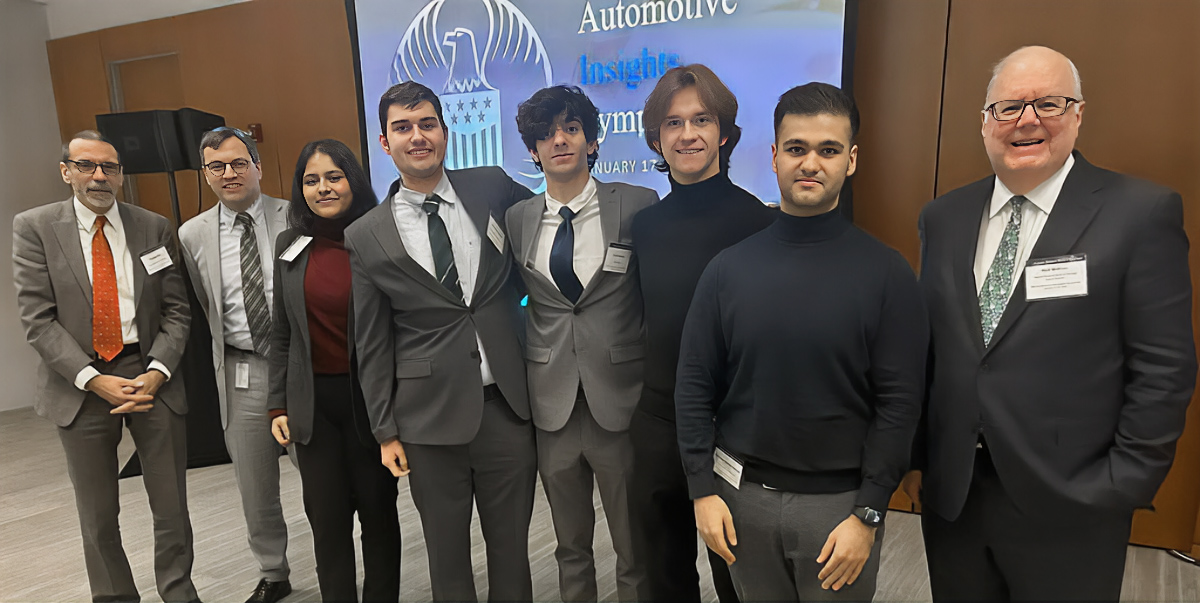Wayne State econ students go to the Federal Reserve and the DEC
A group of Wayne State University economics students attended the 30th Annual Automotive Insights Symposium at the Federal Reserve Bank of Chicago, Detroit Branch, discussing many topics ranging from UAW contracts to electrification in the automotive sector.

Students had the opportunity to meet and network with industry experts from around the globe ranging from world-renowned policy experts, economists, politicians and industry leaders, such as the CEO of Caresoft Global, the global co-leader of the Automotive & Industrial Practice Organization, S&P global associate director of research and analysis, the director of global public policy at Toyota North America and many more.
Here's a dispatch on what they learned, directly from WSU Economics Club President Alexander Gilstorf:
From the symposium
In 2023, we saw better-than-expected automotive sales, the United Auto Workers’ stand-up strike and the full implementation of the Inflation Reduction Act’s electric vehicle incentives.
The strikes are now over, pent-up consumer demand may be winding down, the IRA has been in place for over a year, EV prices are coming down and electrified vehicles are the fastest-growing segments in the U.S. market by far. However, the growth rate of EV sales has slowed recently and automakers and suppliers have started to reassess the speed at which they expect to reach their electrification goals.
How will the future U.S. auto market evolve? Will the U.S. have a mix of propulsion systems for longer than other global markets? Are supply constraints behind us and will 2024 be a more demand-driven market? Will we have enough of everything we need to build vehicles if we get fewer inputs from China? What are the strategies automakers and suppliers will use to address rising costs? These topics and more were covered at the Federal Reserve Bank of Chicago’s 30th Annual Automotive Insights Symposium, held on Jan. 17-18, 2024, at its Detroit Branch.
Through engaging panel discussions and keynote speeches, we explored:
- The 2024 outlook for U.S. and North American auto production, sales and supply chains as the U.S. market moves toward electrification and supply and demand come more into balance.
- The economic impact of the recent UAW contracts and the outlook for future labor relations under these agreements.
- How automakers and suppliers are charting their individual strategic pathways from internal combustion engines toward electrification—and how they plan to lower costs.
- The important role of international trade in the supply chain for critical minerals, batteries and EV components.
- The critical questions about critical minerals: What do we need, are there enough resources, where will they come from and what are the potential bottlenecks for future EV supply?
Through events like this, the Federal Reserve Bank of Chicago serves the public, fostering economic opportunity and advancing a strong economy for our region and nation.
2024 Michigan Economic Outlook
Wayne State University Economics Club members had the opportunity to attend the Detroit Economic Club’s 2024 Michigan Economic Outlook meeting, where members of the club had the opportunity to get a forecast of Michigan’s economy. Students also had the chance to network with Gabriel Ehrich, director of research seminar in quantitative economics at the University of Michigan, Quentin L. Messer, Jr., CEO of the Michigan Economic Development Corporation, Hilary Doe, chief growth officer at the State of Michigan, President Espy, Wayne State University, and Steve Grigorian, president and CEO of the Detroit Economic Club.
The DEC hosted the 2024 Michigan Economic Outlook Meeting on Jan. 16, at the MotorCity Casino Hotel. In a conversation moderated by Daniel Howes, Hilary Doe, chief growth officer of the State of Michigan, Quentin L. Messer, Jr., CEO of the Michigan Economic Development Corporation, and Gabriel Ehrlich, director of research seminar in quantitative economics at the University of Michigan, shared their insights and more.
By Wayne State University Economics Club
